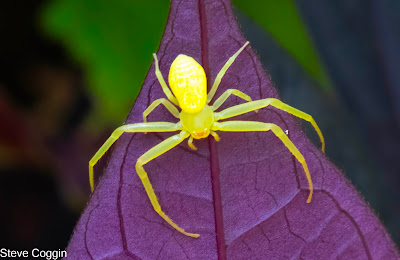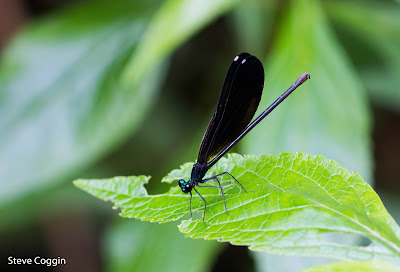 |
| Ailanthus Webworm Moth (Atteva aurea). Rowan County, North Carolina. |
Arthropods are invertebrates with exoskeletons made of chitin and have jointed legs. Examples of arthropods are insects, spiders, crustaceans and centipedes. Arthropods are astonishingly diverse and often strikingly beautiful. And you don’t have to travel to the tropics to experience this diversity. Our home state of North Carolina has an amazing array of arthropods.
Class Insecta includes all the
insects, with nearly 1 million described species. Moths and butterflies are in the Order Lepidoptera,
and we love butterflies because of their dazzling colors and
variety of forms. But moths outnumber butterflies
10 to 1. Some call moths the lesser Lepidoptera and it is true that many are small and
nondescript, but we do have some striking moths in our area.
 |
| Ailanthus Webworm Moth. Rowan County, North Carolina. |
 |
| Eight-spotted Forester (Alypia octomaculata). Rowan County, North Carolina. |
Eight-spotted Foresters (Alypia octomaculata) are native North American moths ranging from the US-Canadian border to Florida and west to the Great Plains. Like most insects, moths have two pairs of wings, and the Eight-spotted Forester has black wings with two white to cream-colored spots per wing, giving it eight spots.
 |
| Saltmarsh Moth (Estigmene acrea). This is a mating pair with' the female above and the male below. Rowan County, North Carolina. |
 |
| Virginia Tiger Moth (Spilosoma virginica). Rowan County, North Carolina. |
The Salt Marsh Moth’s (Estigmene acrea) name is something of a misnomer as it can be found not just in salt marshes but throughout much of North and Central America, . These moths have white forewings decorated with black spots and their legs are striped black and white. We found a pair of Salt Marsh Moths mating on the stem of a plant at a local park. Another white moth in our area is the Virginia Tiger Moth (Spilosoma virginica). This pale species is found across North America.
 |
| Male Luna Moth (Actias luna). Rowan County, North Carolina. |
 |
| The brushy antenna of a male Luna Moth. Rowan County, North Carolina. |
One of the most dramatic moths in our area is the Luna Moth (Actias luna). Luna Moths are large with a wingspan of up to 7 inches. Their wings are pale green and have eye spots on both the fore and hindwings. The front of the forewings is edged in maroon, and the hindwings have trailing spiral tails. The eye spots and the tails are defensive adaptations. The eyes spots fool predators into thinking they have been seen and the tails can be easily shed if the moth is caught by a bird. Adult Luna Moths live for about a week. During that brief time, they must find mates and lay eggs on a host plant, usually a deciduous tree. Female Lunas release a pheromone to attract males. The males have large brushy antennae that can detect minute amounts of the pheromone. This enables the male to fly directly to the female. Adult Luna Moths do not feed because their mouth parts are not functional. They must complete their life cycle fueled by reserves accumulated by the caterpillars. Luna Moths live in eastern parts of the United States and Canada.
 |
| Bicolored Striped Sweat Bee (Agapostemon virescens). Mecklenburg County, North Carolina. |
Bees, wasps and ants are classified in the Order Hymenoptera. Agapostemon virescens, the Bicolored Striped Sweat Bee, is a small brightly colored insect. Its head and thorax are metallic green, and the abdomen has bold yellow and black stripes. These small bees nest in the ground and only the females have a stinger, although they are not aggressive.
 |
| Nest of the Paper Wasp (Polistes sp.). Davidson County, North Carolina. |
Paper Wasps (Polistes sp.) are common in our area. They are predators that feed on insects and make their hanging nests with an array of hexagonal cells each containing a larval wasp. To make their paper nest the wasps chew wood and mix it with saliva. From this macerated wood the wasp forms the nest cells. We found a Paper Wasp nest under the roof of a gazebo that was a perfect hexagon, echoing the shape of the individual cells.
 |
| American Green Crab Spider (Misumena oblongus). Rowan County, North Carolina. |
Spiders are Arthropods in the Class Arachnida, Order Aranea. Over 50,000 species of spiders have been described in the scientific literature. One fall afternoon we spotted a bright yellow spider on the bottom of an ornamental sweet potato leaf. It was a American Green Crab Spider (Misumena oblongus). Goldenrod Crab Spiders often hunt by sitting on a flower and catch insects as they visit. These spiders can change their color to match the flower and the one we saw had probably crawled from a yellow flower. The yellow spider sitting on the deep purple leaf made a striking photo.
Arthropods are so diverse I could
do hundreds of blogs on them, but I will only write one more. Stay tuned for Chapter 2 of Local Arthropods.

























